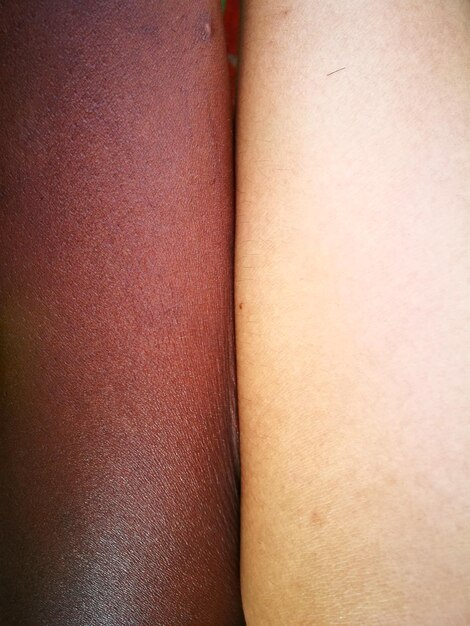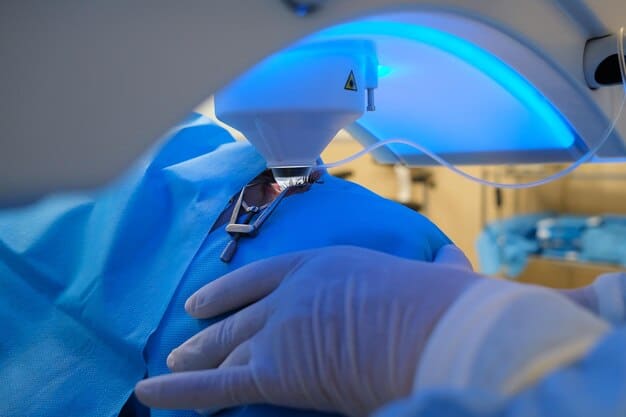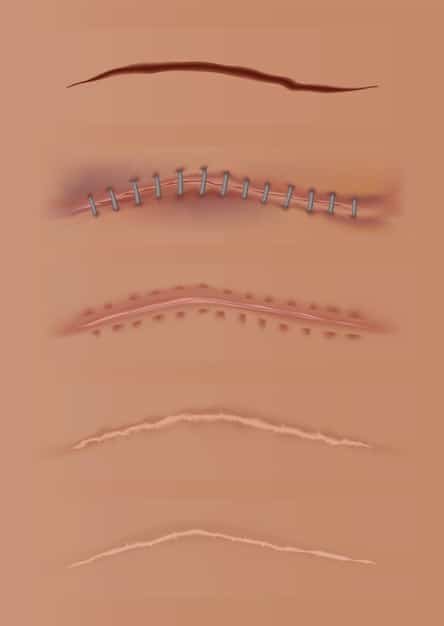Scar Revision Surgery: Your Guide to Minimizing Scars & Improved Skin

Scar revision surgery aims to minimize the appearance of scars, improve skin texture, and restore a more natural look through various techniques, offering patients enhanced confidence and comfort in their skin.
Are you bothered by the appearance of scars? Scar Revision Surgery: Minimizing the Appearance of Scars and Improving Skin Texture by 40% is a cosmetic procedure designed to address unsightly scars, helping you regain smoother, more confident skin. Learn how this procedure works and if it’s right for you.
Understanding Scar Revision Surgery
Scar revision surgery is a specialized field within cosmetic surgery focused on improving the appearance of scars resulting from injury, surgery, burns, or acne. While scars cannot be completely erased, scar revision techniques can significantly minimize their visibility, blend them better with the surrounding skin, and sometimes even improve functionality if a scar is restricting movement.
The goal of scar revision is to create a scar that is less noticeable and more aesthetically pleasing. Various techniques, from simple topical treatments to more complex surgical procedures, can be employed depending on the type, size, location, and severity of the scar.
Types of Scars Addressed
Different types of scars require different approaches. Understanding the type of scar is crucial in selecting the most effective revision method.
- Keloid Scars: Thick, raised scars that extend beyond the original wound site.
- Hypertrophic Scars: Raised scars that remain within the boundaries of the original wound.
- Contracture Scars: Scars that tighten the skin, often occurring after burns, restricting movement.
- Acne Scars: Various types, including ice pick, boxcar, and rolling scars, resulting from acne.

Scar revision surgery can dramatically improve scars that negatively impact your self-esteem and overall quality of life. Whether it’s minimizing the raised texture of a keloid or smoothing out acne scars, the right treatment plan can make a significant difference.
Benefits of Scar Revision
Undergoing scar revision surgery offers numerous benefits beyond just aesthetic improvements. It can significantly boost self-confidence and improve psychological well-being by addressing the visual reminders of past trauma or medical events. Furthermore, it can restore physical function and comfort in cases where scars cause pain or restrict movement.
Ultimately, scar revision can enhance your quality of life by minimizing both the physical and emotional burdens associated with prominent or problematic scars. The decision to undergo scar revision is a personal one, driven by the desire for improved appearance and a greater sense of self-assurance.
Improved Appearance
The primary benefit of scar revision is the noticeable improvement in the scar’s aesthetic appearance. Techniques like laser resurfacing or surgical excision can dramatically reduce the size, shape, and color of scars, making them less conspicuous.
Increased Self-Confidence
Unsightly scars can have a significant impact on self-esteem and body image. By minimizing their appearance, scar revision can help individuals feel more comfortable and confident in their skin, leading to improved social interactions and overall psychological well-being.
Restored Function
In cases where scars restrict movement or cause discomfort, scar revision can restore functionality. For example, contracture scars resulting from burns can limit joint mobility. Scar revision techniques can release the tension and improve range of motion.
Choosing to undergo scar revision surgery is a personal journey toward reclaiming both your physical appearance and your self-confidence.
Types of Scar Revision Techniques
Choosing the right scar revision technique depends on various factors, including the type, size, location, and age of the scar, as well as the patient’s overall health and cosmetic goals. A thorough consultation with a qualified and experienced surgeon is essential to determine the most appropriate approach.
Scar revision can involve a combination of techniques tailored to the specific characteristics of the scar and the desired outcome. These techniques aim to either camouflage, minimize, or change the position of the scar so that it is less noticeable.

Surgical Excision
Surgical excision involves cutting out the entire scar and rejoining the skin with fine sutures. This technique is often used for large or wide scars, as well as for scars that are deeply embedded in the skin.
Laser Resurfacing
Laser resurfacing uses focused beams of light to remove the outer layers of damaged skin, stimulating collagen production and promoting the growth of new, healthier skin. This technique is effective for reducing the appearance of raised scars, discoloration, and uneven skin texture.
Skin Grafting
Skin grafting involves taking skin from one area of the body (the donor site) and transplanting it to the scar site. This technique is commonly used for large or deep scars resulting from burns or trauma. While the graft will still result in a scar, it can improve the overall appearance and function of the affected area.
Ultimately, the selection of the ideal scar can be a life-changing decision, restoring skin, self-confidence and physical well-being.
The Scar Revision Procedure: What to Expect
Understanding the scar revision procedure can help alleviate any anxiety and better prepare you for the process. Typically, the process begins with a comprehensive consultation to assess your needs and goals. On the day of the surgery, you’ll receive anesthesia for comfort. Then, the surgical procedure, chosen based on the type, size, and location of the scar, is performed.
You’ll receive detailed post-operative care instructions. Following these instructions will help ensure optimal healing and results. Remember, the recovery process isn’t just about physical healing––it’s also about emotional adjustment as you begin to see the improvements.
Consultation and Assessment
During the initial consultation, the surgeon will evaluate the scar, review your medical history, and discuss your goals and expectations. This is also the time to ask any questions and address any concerns you may have.
Anesthesia
Depending on the extent of the scar revision, local or general anesthesia may be used. Local anesthesia numbs the area around the scar, while general anesthesia puts you to sleep during the procedure.
Post-operative Care
Post-operative care is critical for proper healing. You’ll receive instructions on wound care, pain management, and activity restrictions. Follow these guidelines carefully to minimize the risk of complications and optimize results.
Scar revision surgery offers a pathway to improved skin appearance and a renewed sense of self-assurance. Embrace the journey with a realistic perspective, and celebrate the positive outcomes as they unfold.
Preparing for Scar Revision Surgery
Proper preparation can significantly impact the success of your scar revision surgery. One essential step is to consult with a qualified and experienced surgeon, as their expertise will guide you through the process. It’s also important to optimize your health before surgery by following a balanced diet and avoiding smoking.
You’ll need to arrange for post-operative care, ensuring you have assistance during the initial recovery period. This proactive approach helps create a smooth, supportive experience, maximizing the potential for excellent results.
Medical Evaluation
Your surgeon will conduct a thorough medical evaluation to assess your overall health and identify any potential risk factors. Be sure to disclose any pre-existing medical conditions, allergies, and medications you are taking.
Lifestyle Adjustments
Adopting healthy lifestyle habits can improve your body’s ability to heal. Stop smoking, limit alcohol consumption, and maintain a balanced diet rich in vitamins and nutrients.
Preparing for scar revision surgery is about more than just the physical steps; it’s also about setting realistic expectations and mentally preparing for the journey. With the right planning and support, you can approach your procedure with confidence and optimism.
Potential Risks and Complications
Like any surgical procedure, scar revision surgery carries potential risks and complications. Being aware of these risks allows you to make informed decisions and take necessary precautions. Some common risks include infection, which can be managed with antibiotics, and bleeding, which is usually minimal.
Adverse reactions to anesthesia can also occur, though they are rare. It’s essential to communicate openly with your surgical team to address any concerns and ensure your safety throughout the process.
- Infection: Infections can occur at the surgical site, requiring antibiotic treatment.
- Bleeding: Excessive bleeding during or after surgery is possible but rare.
- Adverse Reactions to Anesthesia: Anesthetic reactions can range from mild to severe, but are generally uncommon.
- Nerve Damage: Nerve damage can result in numbness, tingling, or pain at the surgical site.
Understanding potential risks and complications ensures you are well-informed and prepared for your scar revision journey. Addressing concerns proactively helps create a sense of confidence and control, contributing to a more positive overall experience.
Scar revision surgery offers hope and transformation for those burdened by unsightly scars. With careful planning, a skilled surgeon, and realistic expectations, you can achieve remarkable improvements in skin appearance and quality of life.
| Key Point | Brief Description |
|---|---|
| ✅ Scar Types | Different scars (keloid, hypertrophic, etc.) require different treatments. |
| 💡 Revision Benefits | Improved appearance, confidence, and restored function. |
| 🛠️ Techniques | Excision, laser, skin grafting, and other methods. |
| 🩹 Preparation | Medical evaluation, lifestyle adjustments, and realistic expectations. |
Frequently Asked Questions
▼
The primary goal is to minimize the appearance of scars, improve skin texture, and blend scars better with the surrounding skin, thereby enhancing overall aesthetic appearance and self-confidence.
▼
Scar revision can address various types of scars, including keloid, hypertrophic, contracture, and acne scars. The specific treatment approach varies depending on the scar type and characteristics.
▼
Recovery time varies based on the type and extent of the procedure. Generally, initial healing takes a few weeks, but it may take several months for the scar to fully mature and the final results to become visible.
▼
While scar revision can significantly improve the appearance of scars, it is important to remember that scars cannot be completely erased. The improvements achieved are generally long-lasting, but new injuries can still result in new scars.
▼
Risks include infection, bleeding, adverse reactions to anesthesia, nerve damage, and unsatisfactory cosmetic outcomes. Choosing an experienced surgeon and following post-operative care instructions can help minimize these risks.
Conclusion
Scar revision surgery offers a promising solution for individuals seeking to minimize the appearance of scars and improve their skin texture. By exploring the various techniques and understanding the procedure, preparation, and potential risks, you can make an informed decision. Consult with a qualified surgeon to determine the best approach for your specific needs and embark on a journey toward enhanced confidence and smoother skin.





